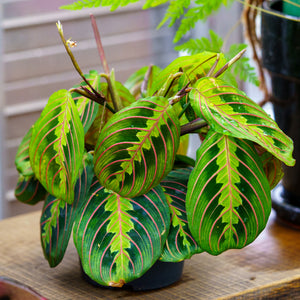The Maranta Guide
Maranta, commonly known as the Prayer Plant, brings a touch of vibrant color and tropical beauty to any garden or indoor space. With their intricate leaf patterns and unique folding behavior, Maranta plants are perfect for adding a dynamic focal point to containers, hanging baskets, and interior decor. Admired for their ability to thrive in a variety of conditions, Maranta plants offer a captivating and low-maintenance solution for plant enthusiasts. Explore our Maranta Guide to learn more about cultivating and caring for these fascinating plants and discover how to incorporate them into your home or garden for lasting beauty and enjoyment.
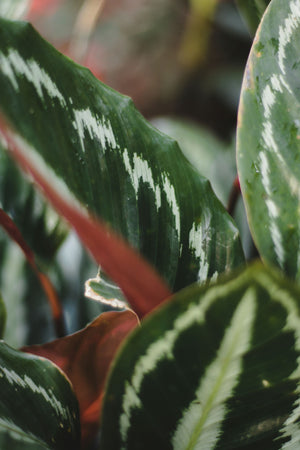
About
Maranta is a genus of flowering plants in the Marantaceae family, native to the tropical regions of Central and South America. These plants are named after Bartolomeo Maranta, an Italian physician and botanist. Maranta is known for its stunning foliage, with leaves that feature bold patterns, contrasting veins, and vibrant hues of green, red, purple, and cream.
The Prayer Plant gets its name from the unique way its leaves fold upward at night, resembling hands in prayer. This nyctinastic movement is a response to changes in light and is one of the most captivating features of Maranta.
Maranta plants are relatively compact, making them ideal for indoor cultivation. Their air-purifying properties add a functional benefit to their ornamental appeal, making them a favorite among plant enthusiasts.
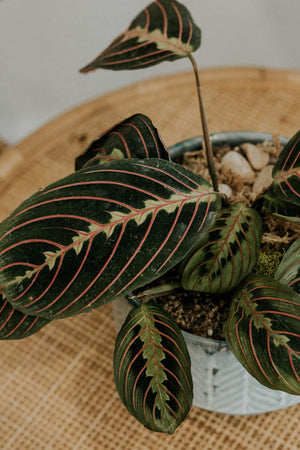
Planting
Creating the right environment is essential for Maranta plants to thrive. Follow these guidelines for planting and maintaining healthy growth:
- Soil: Use a well-draining, nutrient-rich potting mix. A mix of peat moss, perlite, and standard potting soil provides the ideal balance of moisture retention and aeration.
- Light: Maranta thrives in bright, indirect light. Avoid direct sunlight, which can scorch the leaves and cause colors to fade. They can tolerate lower light conditions, but their growth may slow.
- Watering: Keep the soil evenly moist but not soggy. Water thoroughly, allowing the top inch of soil to dry out between waterings. Maranta is sensitive to chlorine and fluoride, so use filtered or distilled water if possible.
- Humidity: High humidity is essential for Maranta plants. Increase humidity by misting the leaves regularly, using a humidifier, or placing the plant on a pebble tray with water.
- Temperature: Maintain a consistent temperature between 65-75°F (18-24°C). Avoid placing Maranta near cold drafts or heat sources that can cause stress.
- Container: Choose a pot with drainage holes to prevent waterlogging. Hanging baskets or decorative pots work well for showcasing their trailing habit.
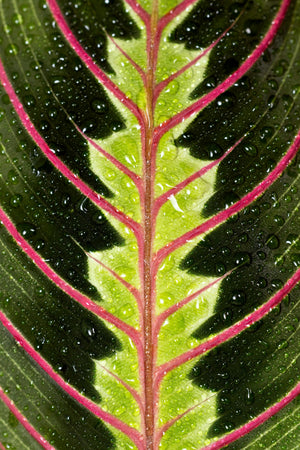
Care
Maranta plants are relatively low-maintenance, provided they are given the proper care. Follow these tips to ensure their health and beauty:
- Watering: Reduce watering in winter when the plant’s growth slows. Consistent moisture is key, but overwatering should be avoided to prevent root rot.
- Fertilizing: Feed Maranta with a balanced, water-soluble fertilizer diluted to half strength every 4-6 weeks during the growing season (spring and summer). Avoid over-fertilizing, as this can damage the plant’s roots.
- Pruning: Remove any yellow or damaged leaves to encourage healthy growth and maintain the plant’s appearance. Regularly trim leggy stems to promote a bushier shape.
- Propagation: Maranta can be propagated by division or stem cuttings. Ensure cuttings have at least one node and root them in water or moist soil.
- Pests and Diseases: Maranta is susceptible to spider mites, mealybugs, and scale. Check regularly for signs of pests and treat infestations promptly with neem oil or insecticidal soap. Ensure proper watering to reduce the risk of fungal diseases.
- Repotting: Repot Maranta every 1-2 years or when it becomes root-bound. Refresh the soil and choose a slightly larger pot to encourage growth.
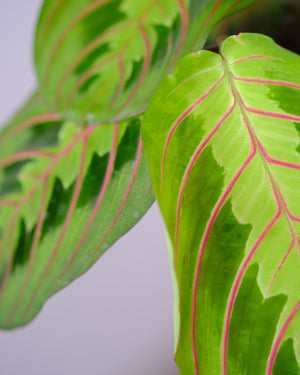
How To Use
Maranta’s vibrant patterns and unique growth habits make it a standout in any setting. Here’s how you can use Maranta to enhance your spaces:
- Indoor Decor: Place Maranta in decorative pots on shelves, coffee tables, or windowsills to add a touch of tropical elegance. Its colorful foliage complements a wide range of interior styles.
- Office Spaces: Maranta’s ability to thrive in low to medium light makes it a perfect choice for offices. Add it to desks or reception areas for a pop of color and improved air quality.
- Hanging Baskets: Showcase Maranta’s trailing stems in hanging baskets, where its leaves can cascade gracefully for a dynamic display.
- Living Walls: Incorporate Maranta into living wall arrangements for a lush, textural look. Its unique leaf patterns bring variety to vertical gardens.
- Terrariums: Maranta thrives in terrariums, where its humidity needs can be easily met. Pair it with other tropical plants for a stunning miniature ecosystem.
- Table Centerpieces: Use Maranta in low-profile arrangements to create elegant centerpieces for dining or coffee tables.
The Prayer Plant’s vibrant colors and interactive leaves make it a conversation starter, bringing life and movement to your decor.
Conclusion
Maranta is a captivating and versatile addition to any indoor or garden space. With their intricate foliage, unique prayer-like movement, and minimal care requirements, Maranta plants bring both beauty and functionality to your environment. Their ability to thrive in diverse conditions makes them a favorite among plant lovers of all levels.
Whether you’re creating an indoor tropical retreat, enhancing your office decor, or experimenting with living art, Maranta plants offer endless possibilities for creativity and inspiration. By following proper planting and care techniques, you can enjoy these extraordinary plants for years to come. Explore the world of Maranta and let their enduring charm and vibrant patterns enhance your space with natural beauty and elegance.


